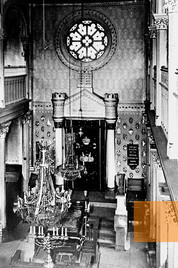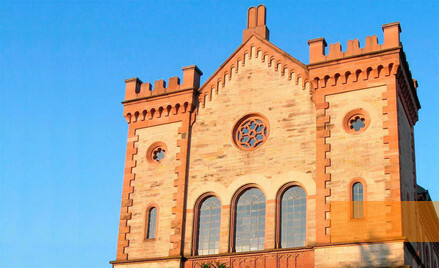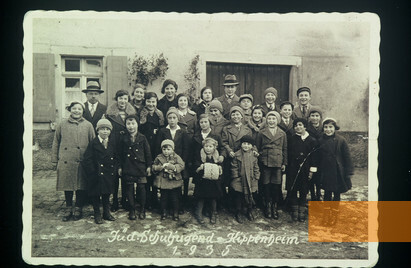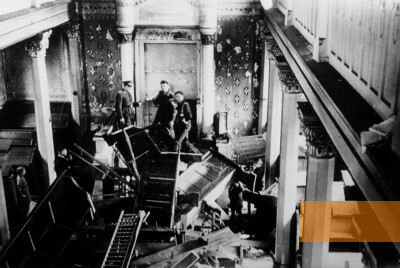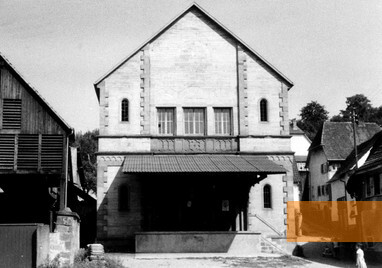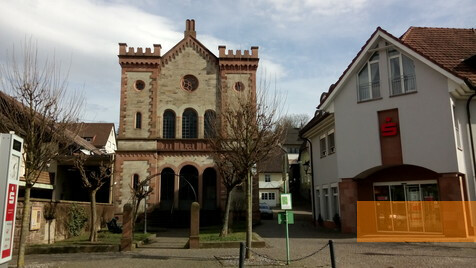The Kippenheim synagogue, a listed building built in 1852, is used today as an educational institution.
Kippenheim is a community in the Ortenau district in the Upper Rhine region, which was already mentioned in a written document dating from 762. Jews lived in Kippenheim at the latest since the 17th century. At that time Jews were not allowed to settle in towns, so that a peculiar culture of rural Jewry developed in the region. In the 19th century there was a relatively large Jewish community in Kippenheim, whose population reached its peak in 1871 with 323 members - which meant that at that time almost every sixth Kippenheim resident was Jewish. After that the number of Jews living in Kippenheim decreased continuously. The centre of Jewish life was the synagogue built in 1852 in the neo-Romanesque style.
When the National Socialists came to power in 1933, 144 Jews lived in Kippenheim out of a total population of 1,856. Before that, Jews had played an active role in the social and economic life of the community; businesses such as inns, cattle trades and bakeries ensured the existence of Jewish families. Under the Nazi regime, their situation became increasingly precarious: calls for boycotts were followed by racial laws and an increasing ousting from public life. On November 10, 1938 members of the Hitler Youth from Lahr destroyed the interior of the synagogue. Because of the anti-Semitic mood, most of the Jewish inhabitants left Kippenheim, many of them left Germany altogether.
On October 22 and 23, 1940 in the »Wagner-Bürckel-Aktion«, all Jews from the Saar-Palatinate and Baden, including all 31 Jewish men and women still living in Kippenheim, were deported to southern France and locked up in a camp in Gurs. This »Aktion« was the first major deportation of Jews from the German Reich. Most deportees died in Gurs or were later deported to the Auschwitz-Birkenau extermination camp and murdered there.
When the National Socialists came to power in 1933, 144 Jews lived in Kippenheim out of a total population of 1,856. Before that, Jews had played an active role in the social and economic life of the community; businesses such as inns, cattle trades and bakeries ensured the existence of Jewish families. Under the Nazi regime, their situation became increasingly precarious: calls for boycotts were followed by racial laws and an increasing ousting from public life. On November 10, 1938 members of the Hitler Youth from Lahr destroyed the interior of the synagogue. Because of the anti-Semitic mood, most of the Jewish inhabitants left Kippenheim, many of them left Germany altogether.
On October 22 and 23, 1940 in the »Wagner-Bürckel-Aktion«, all Jews from the Saar-Palatinate and Baden, including all 31 Jewish men and women still living in Kippenheim, were deported to southern France and locked up in a camp in Gurs. This »Aktion« was the first major deportation of Jews from the German Reich. Most deportees died in Gurs or were later deported to the Auschwitz-Birkenau extermination camp and murdered there.
In October 1940 the National Socialist authorities deported all 31 Jews still living in Kippenheim to Gurs. 29 of them did not survive the Holocaust. 12 died in Gurs, 17 were murdered in the Auschwitz-Birkenau extermination camp in 1942/43. In total, approximately 400 Jews from the Ortenau district were murdered in the Holocaust.
On November 10, 1938 local residents prevented the synagogue from burning down because they feared that the flames could spread to the surrounding buildings. The leadership of the community wanted to demolish the synagogue, but this did not happen in the following years. During the Second World War, the building was looted even further because French prisoners of war, who were housed in the immediate vicinity, needed material for heating.
After 1945 the synagogue was confiscated at the instigation of the Allies and returned to Jewish organisations, but they had no further use for it and soon sold it again. The building was then used as a warehouse and became less and less recognisable as a former synagogue. The two towers were also removed in the 1950s.
In the late 1970s, there were more and more voices in favour of saving the former synagogue from oblivion. In 1981 the synagogue was raised to the rank of a »cultural monument of national importance«. In 1983 the municipality of Kippenheim bought the building and had the original façade restored. In 2003, the Förderverein Ehemalige Synagoge Kippenheim e. V. (Friend’s Association of the Former Kippenheim Synagogue), which was founded in 1996, had the former synagogue extensively renovated. The renovation concept developed by the friend’s association tries to keep the traces of history visible in order to make the different uses of the building since its construction as visible as possible.
The association offers guided tours and other educational activities for young people and adults. A permanent exhibition in the galleries informs about the culture and history of the Ortenau rural Jews.
After 1945 the synagogue was confiscated at the instigation of the Allies and returned to Jewish organisations, but they had no further use for it and soon sold it again. The building was then used as a warehouse and became less and less recognisable as a former synagogue. The two towers were also removed in the 1950s.
In the late 1970s, there were more and more voices in favour of saving the former synagogue from oblivion. In 1981 the synagogue was raised to the rank of a »cultural monument of national importance«. In 1983 the municipality of Kippenheim bought the building and had the original façade restored. In 2003, the Förderverein Ehemalige Synagoge Kippenheim e. V. (Friend’s Association of the Former Kippenheim Synagogue), which was founded in 1996, had the former synagogue extensively renovated. The renovation concept developed by the friend’s association tries to keep the traces of history visible in order to make the different uses of the building since its construction as visible as possible.
The association offers guided tours and other educational activities for young people and adults. A permanent exhibition in the galleries informs about the culture and history of the Ortenau rural Jews.
- Name
- Ehemalige Synagoge Kippenheim
- Address
-
Poststraße 17
77971 Kippenheim - Phone
- +49 (0)7807 957 612
- Web
- http://www.ehemalige-synagoge-kippenheim.de/
- buero@ehemalige-synagoge-kippenheim.de
- Open
- May to end of September Sundays 2 p.m. to 5 p.m.
Guided tours on request - Possibilities
- Permanent exhibition, guided tours, educational offers, cultural events


